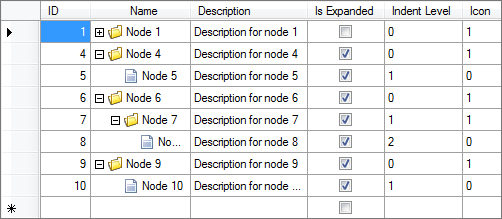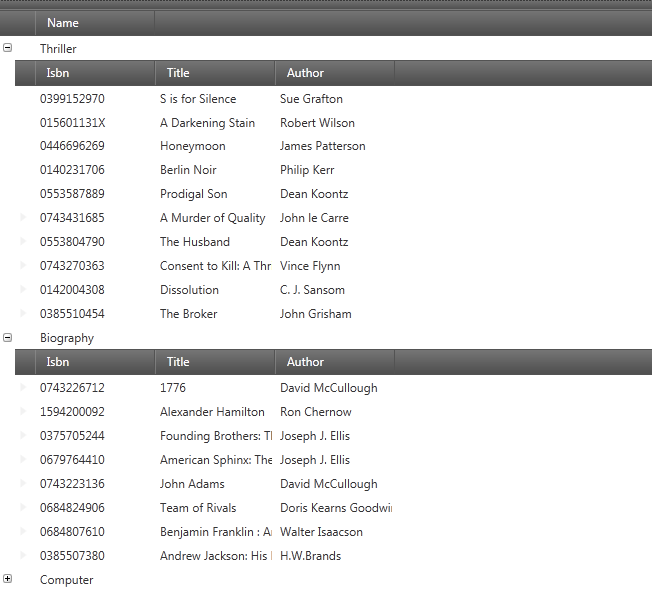Hierarchical Datagridview

Trace Cannon 1-May-17 19:23 1-May-17 19:23 I am a student learning C# for the first time. Our final was to create a program that allow for user input while showing the user the current order list(like the amazon cart). My group tired to use a listview but I knew it could be done better by using the DataGridView(DGV).

I have a scenario where i have to group the PinCode by city name like one city can have many pincode. I have to do this in winform in datagrid. How can i do this so.
I have spent the last three to four weeks trying to set the user data to be readable by the DGV. Finally I found your explanations of BindingSources. With it I was able to have data from a combobox and text boxes shown in the DGV. Thank you so much for writing this!!!! You are truly my savior for this project! If you every find yourself in Indiana I owe you a dinner of your choosing! Thank you again!
Ankkor 12-Nov-16 12:36 12-Nov-16 12:36 I'm new to C# but not to programming. I've been toying with a DataGridView with no trouble. Then I hit a wall trying to get a data-bound combobox (connected to the same BindingSource as the grid) to automatically display the matching 'desc'(DisplayMember) from it's list of objects.
It's been 2 days and finally your article tells me The ' SelectedValue' property of ComboBox or ListBox. Everything else connected the 'Text' property of the combobox. Of course now it makes sense. Fantastic article. Rapidshare Mixmeister Fusion Demo. ArunR2 20-Aug-13 2:05 20-Aug-13 2:05 I was tasked with updating an existing windows form with loads of databindings on it.
Having never worked with databindings before it was just too much for me. The standard documentation was confusing and time consuming. But stumbled on this one, just what the doctor ordered!
Spent half hour following the tutorials and now I'm on my way to implement my changes! I wish other tutorials were up to this standard, or even better - wish I could come up with something like this. Thank you very much.
The control is a new control that replaces the control. The control provides numerous basic and advanced features that are missing in the control. Additionally, the architecture of the control makes it much easier to extend and customize than the control. The following table describes a few of the primary features available in the control that are missing from the control. DataGridView control feature Description Multiple column types The control provides more built-in column types than the control.
These column types meet the needs of most common scenarios, but are also easier to extend or replace than the column types in the control. For more information, see. Multiple ways to display data The control is limited to displaying data from an external data source. The control, however, can display unbound data stored in the control, data from a bound data source, or bound and unbound data together. You can also implement virtual mode in the control to provide custom data management. For more information, see. Multiple ways to customize the display of data The control provides many properties and events that enable you to specify how data is formatted and displayed.
For example, you can change the appearance of cells, rows, and columns depending on the data they contain, or you can replace data of one data type with equivalent data of another type. For more information, see. Multiple options for changing cell, row, column, and header appearance and behavior The control enables you to work with individual grid components in numerous ways. For example, you can freeze rows and columns to prevent them from scrolling; hide rows, columns, and headers; change the way row, column, and header sizes are adjusted; change the way users make selections; and provide ToolTips and shortcut menus for individual cells, rows, and columns.
The control is retained for backward compatibility and for special needs. For nearly all purposes, you should use the control. The only feature that is available in the control that is not available in the control is the hierarchical display of information from two related tables in a single control. You must use two controls to display information from two tables that are in a master/detail relationship. Upgrading to the DataGridView Control If you have existing applications that use the control in a simple data-bound scenario without customizations, you can simply replace the old control with the new control. Both controls use the standard Windows Forms data-binding architecture, so the control will display your bound data with no additional configuration needed.
You might want to consider taking advantage of data-binding improvements, however, by binding your data to a component, which you can then bind to the control. For more information, see. Because the control has an entirely new architecture, there is no straightforward conversion path that will enable you to use customizations with the control. Many customizations are unnecessary with the control, however, because of the built-in features available in the new control. If you have created custom column types for the control that you want to use with the control, you will have to implement them again using the new architecture. For more information, see.